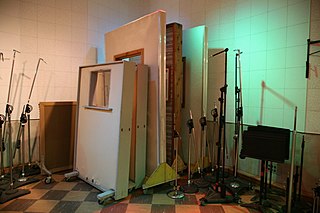Related Research Articles

An effects unit, effects processor, or effects pedal is an electronic device that alters the sound of a musical instrument or other audio source through audio signal processing.
In music, tremolo, or tremolando, is a trembling effect. There are multiple types of tremolo: a rapid repetition of a note, an alternation between two different notes, or a variation in volume.

Dynamic range compression (DRC) or simply compression is an audio signal processing operation that reduces the volume of loud sounds or amplifies quiet sounds, thus reducing or compressing an audio signal's dynamic range. Compression is commonly used in sound recording and reproduction, broadcasting, live sound reinforcement and some instrument amplifiers.

Soundtrack Pro is a discontinued music composing and audio editing application made by Apple Inc. It included a collection of just over 5,000 royalty free professional instrument loops and sound effects for use. The software was featured in the Logic Studio and Final Cut Studio software bundles; It was discontinued with the release of Final Cut Pro X, Motion 5, and Compressor 4.

A noise gate or simply gate is an electronic device or software that is used to control the volume of an audio signal. Comparable to a compressor, which attenuates signals above a threshold, such as loud attacks from the start of musical notes, noise gates attenuate signals that register below the threshold. However, noise gates attenuate signals by a fixed amount, known as the range. In its simplest form, a noise gate allows a main signal to pass through only when it is above a set threshold: the gate is "open". If the signal falls below the threshold, no signal is allowed to pass : the gate is "closed". A noise gate is used when the level of the "signal" is above the level of the unwanted "noise". The threshold is set above the level of the "noise", and so when there is no main "signal", the gate is closed.
In audio engineering, ducking is an audio effect commonly used in radio and pop music, especially dance music. In ducking, the level of one audio signal is reduced by the presence of another signal. In radio this can typically be achieved by lowering (ducking) the volume of a secondary audio track when the primary track starts, and lifting the volume again when the primary track is finished. A typical use of this effect in a daily radio production routine is for creating a voice-over: a foreign language original sound is dubbed by a professional speaker reading the translation. Ducking becomes active as soon as the translation starts.
Panning is the distribution of an audio signal into a new stereo or multi-channel sound field determined by a pan control setting. A typical physical recording console has a pan control for each incoming source channel. A pan control or pan pot is an analog control with a position indicator which can range continuously from the 7 o'clock when fully left to the 5 o'clock position fully right. Audio mixing software replaces pan pots with on-screen virtual knobs or sliders which function like their physical counterparts.

There are a number of well-developed microphone techniques used for recording musical, film, or voice sources or picking up sounds as part of sound reinforcement systems. The choice of technique depends on a number of factors, including:
Parallel compression, also known as New York compression, is a dynamic range compression technique used in sound recording and mixing. Parallel compression, a form of upward compression, is achieved by mixing an unprocessed 'dry', or lightly compressed signal with a heavily compressed version of the same signal. Rather than lowering the highest peaks for the purpose of dynamic range reduction, it decreases the dynamic range by raising up the softest sounds, adding audible detail. It is most often used on stereo percussion buses in recording and mixdown, on electric bass, and on vocals in recording mixes and live concert mixes.

Live sound mixing is the blending of multiple sound sources by an audio engineer using a mixing console or software. Sounds that are mixed include those from instruments and voices which are picked up by microphones and pre-recorded material, such as songs on CD or a digital audio player. Individual sources are typically equalised to adjust the bass and treble response and routed to effect processors to ultimately be amplified and reproduced via a loudspeaker system. The live sound engineer listens and balances the various audio sources in a way that best suits the needs of the event.

"Bring the Noise" is a song by the American hip hop group Public Enemy. It was included on the soundtrack of the 1987 film Less than Zero; the song was also released as a single that year. It later became the first song on the group's 1988 album, It Takes a Nation of Millions to Hold Us Back. The single reached No. 56 on the Billboard Hot R&B/Hip-Hop Songs chart.

This is a discography of the Italian DJ and producer Benny Benassi.

In sound recording and reproduction, audio mixing is the process of optimizing and combining multitrack recordings into a final mono, stereo or surround sound product. In the process of combining the separate tracks, their relative levels are adjusted and balanced and various processes such as equalization and compression are commonly applied to individual tracks, groups of tracks, and the overall mix. In stereo and surround sound mixing, the placement of the tracks within the stereo field are adjusted and balanced. Audio mixing techniques and approaches vary widely and have a significant influence on the final product.
A mixing engineer is responsible for combining ("mixing") different sonic elements of an auditory piece into a complete rendition, whether in music, film, or any other content of auditory nature. The finished piece, recorded or live, must achieve a good balance of properties, such as volume, pan positioning, and other effects, while resolving any arising frequency conflicts from various sound sources. These sound sources can comprise the different musical instruments or vocals in a band or orchestra, dialogue or Foley in a film, and more.

"Beautiful People" is a song by American singer Chris Brown featuring Italian DJ Benny Benassi, released as the third single from Brown's fourth studio album F.A.M.E. on March 11, 2011 . It was written by Brown, with Benny Benassi and Alle Benassi handling its production. Musically, "Beautiful People" is an uptempo song which draws from the genres of progressive house and Europop, containing influences of dancehall and R&B. The song's lyrics revolve around Brown encouraging people to be positive discovering their inside beauty.

Spill is the occurrence in sound recording and live sound mixing whereby sound is picked up by a microphone from a source other than that which is intended. Spill is usually seen as a problem, and various steps are taken to avoid it or reduce it. In some styles of music, such as orchestral music, jazz, and blues, it is more likely to be accepted or even seen as desirable.
In audio and recording, what is known colloquially as an anchor point is a center position in a stereo mix reserved for only three or four important tracks. Most modern pop productions are anchored by lead, bass, kick drum, and snare drum. These are usually within a few degrees of center (horizontal) and front in the mix. Exceptions include early stereo recordings using "stereo-switching" rather than pan pots) such as the Beatles's "Strawberry Fields Forever" and Jimi Hendrix's "Purple Haze". Examples of tracks using anchor points include The Breeders's "Cannonball", The Cure's "Catch", Lady Gaga's "Just Dance", Lily Allen's "The Fear", Radiohead's "Airbag", Squarepusher's "Star Time 2", Stone Roses' "One Love", and Weezer's "My Name Is Jonas".
Electro house is a genre of electronic dance music and a subgenre of house music characterized by heavy bass and a tempo around 125–135 beats per minute. The term has been used to describe the music of many DJ Mag Top 100 DJs, including Benny Benassi, Skrillex, Steve Aoki, and Deadmau5.
Rocco Rampino, better known as Congorock, is an Italian producer and DJ. He is best known for his song "Babylon" in 2010.
In sound and music, an envelope describes how a sound changes over time. For example, a piano key, when struck and held, creates a near-immediate initial sound which gradually decreases in volume to zero. An envelope may relate to elements such as amplitude (volume), frequency or pitch.
References
- ↑ Izhaki, Roey (2008). Mixing Audio, p.160. Focal Press. Cited in Hodgson, Jay (2010). Understanding Records, p.81. ISBN 978-1-4411-5607-5.
- ↑ Case, Alex (2007). Sound FX, p.160. Focal Press. Cited in Hodgson (2010), p.81.
- 1 2 3 Hodgson, J. (2010). Understanding Records: A Field Guide To Recording Practice. Bloomsbury Publishing. ISBN 9781441124098.